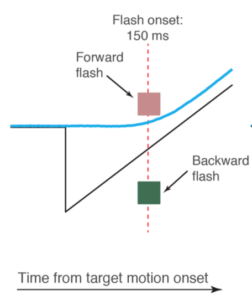 We have a new paper in press at the Journal of Neuroscience. In this study, we explored the influences of sudden sensory transients on the initiation of smooth pursuit eye movements. These eye movements are smooth, continuous rotations of the eyeball to follow a continuously moving target, such as a flying bird or a cyclist passing by. During smooth pursuit initiation, the visual system integrates information from moving retinal images in order to obtain a best estimate of the needed eye rotation speed. It has historically become assumed that the first ~100 ms of initial eye acceleration during smooth pursuit initiation constitute an obligatory “open-loop” interval in which smooth pursuit is basically unmodifiable. However, this seems to be in direct contradiction with findings that the oculomotor system, indeed the brain in general, is extremely sensitive to sensory trnsients and with extremely short latencies. For example, we have recently found that superior colliculus neurons can respond to visual onsets in less than 50 ms (paper here). Moreover, microsaccades can be influenced by sudden onsets within a similar time frame (e.g. this paper, or this paper, or this paper). We therefore explored for potential modifications of smooth pursuit eye movements during the so-called “open-loop” interval.
We have a new paper in press at the Journal of Neuroscience. In this study, we explored the influences of sudden sensory transients on the initiation of smooth pursuit eye movements. These eye movements are smooth, continuous rotations of the eyeball to follow a continuously moving target, such as a flying bird or a cyclist passing by. During smooth pursuit initiation, the visual system integrates information from moving retinal images in order to obtain a best estimate of the needed eye rotation speed. It has historically become assumed that the first ~100 ms of initial eye acceleration during smooth pursuit initiation constitute an obligatory “open-loop” interval in which smooth pursuit is basically unmodifiable. However, this seems to be in direct contradiction with findings that the oculomotor system, indeed the brain in general, is extremely sensitive to sensory trnsients and with extremely short latencies. For example, we have recently found that superior colliculus neurons can respond to visual onsets in less than 50 ms (paper here). Moreover, microsaccades can be influenced by sudden onsets within a similar time frame (e.g. this paper, or this paper, or this paper). We therefore explored for potential modifications of smooth pursuit eye movements during the so-called “open-loop” interval.
 We found that, indeed, smooth eye velocity is easily and robustly modifiable by visual transients. Moreover, the modifications were perfectly in line with modifications expected for saccades and microsaccades. Therefore, the same underlying mechanisms likely influence all types of eye movements. Our results point to specific neurophysiological substrates that we believe can influence such modifications, and follow-up experiments in our lab will investigate them.
We found that, indeed, smooth eye velocity is easily and robustly modifiable by visual transients. Moreover, the modifications were perfectly in line with modifications expected for saccades and microsaccades. Therefore, the same underlying mechanisms likely influence all types of eye movements. Our results point to specific neurophysiological substrates that we believe can influence such modifications, and follow-up experiments in our lab will investigate them.
We were also struck by the reliable effects of sudden visual onsets on the oculomotor system. In our experiments, we used very brief, barely noticeable stimuli. When experiencing these stimuli ourselves in the lab, they seemed so innocuous to us, and they were almost unnoticed (certainly, not to the level of assuming they influenced our eye movements so reliably). These stimuli, therefore, subjectively felt like they can have minimal impacts on brain state. Yet, they caused very robu
st effects on our eye movements. To us, this points to an importance of being cognisant of experimental manipulations that vision and cognitive scientists might often employ in their tasks. Such manipulations may seem subtle subjectively, but they can have strong and lasting impacts on brain state. This is certainly intriguing to us.
The paper can be read in its pre-print form here.
